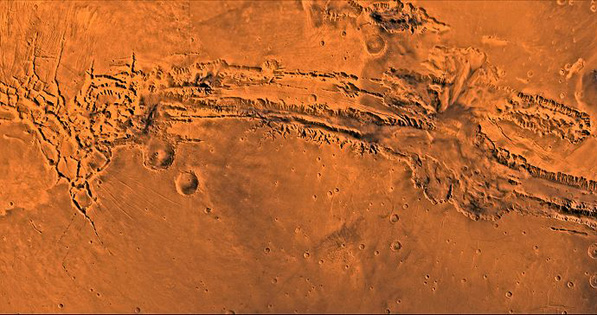
The red planet is my favorite planet. I consider it a friend. When, in 2003, the orbits of earth and Mars passed as close as they had in 60,000 years, I walked home nights after teaching and looked up and there it was. Amazing Mars: big and red and near, a ruby set on a black velvet sky.
We’re the third planet out from the Sun, and Mars is fourth, the farthest out of the terrestrial planets. With a smaller orbit, Earth goes around the Sun twice for every time Mars goes around, and at a different speed (faster). One Mars year is 23 Earth-months long.
The two orbits are not circular but elliptical. Because of this and because Earth and Mars are at times on opposite sides of the Sun, the distance between the two planets varies greatly, from an average of 140 million miles to just a tad closer than that 35-million-mile approach during the summer of 2003.
Mars is windy, dusty, and cold. It has white polar caps made of dry ice (carbon dioxide ice). It has water ice under the dry ice. It has tremendous dust storms. It does not have Martians. (Still, The War of the Worlds is a great read. The classic sci-fi novel by H. G. Wells, published in 1898, does have Martians.)
The surface of Mars is bone dry. The atmosphere is thin, very thin. A mug of coffee on Mars would immediately evaporate. That’s why I’m staying here. The air is carbon dioxide with a bit of water vapor and, most intriguing, bursts of methane.
Mars is smaller. Its radius is half, and its mass 10 percent that of Earth. This, it turns out, matters in the puzzle of what happened to Mars. Because something did happen to Mars. It was once warmer and wetter. Its geography includes channels, ditches, and layered sediments, features indicating a past of flowing water—gushes, puddles, creeks, rivers, lakes, maybe even an ocean.
The red planet does amaze. It has the tallest known volcano in the solar system. Olympus Mons reaches about 16 miles high and its base is larger than the entire state of Washington. A cliff (or scarp) that rims this massive mountain rises to nearly four miles high. Mars has a Grand Canyon, called Valles Marineris, which would, were it here, yawn from New York to Los Angeles.
What did happen to Mars? The question is open and as yet unanswered. Its original atmosphere, like that of Earth and Venus, came mostly from the outgassing of volcanoes. Carbon dioxide is a greenhouse gas. A thick carbon dioxide atmosphere would have warmed Mars, and a warmer Mars would have rained liquid water. Microbial life may have stirred.
If Mars once had a thick atmosphere, then where did it go? This brings us to convection currents. The molten part of Earth’s iron core constantly moves, hotter molten metal rising, cooler molten metal sinking. Convection currents create Earth’s electromagnetic envelope, our security blanket. The electromagnetic envelope blocks solar wind. Solar wind, which fills our entire solar system (except where blocked), comprises highly charged particles emitted by the sun, particles that molest molecules and kidnap atoms.
In its first billion years, Mars had a molten core, convection currents, active volcanoes, and an electromagnetic envelope. But, being smaller, it cooled, convection ended, volcanoes fell quiet, and the electromagnetic envelope was lost. It’s likely that solar wind wiped out its atmosphere. Ultraviolet photons likely had a hand, breaking apart the water vapor (H20), with hydrogen escaping to space and oxygen combining with rocks to rust Mars red.
Did microbial life develop? If it did develop did any of it survive in buried pockets of water. (Thus methane?) That is a main question that Curiosity, NASA’s robotic Mars rover scheduled to land this August, will be looking to answer. Down here, we gaze up and we wonder.

